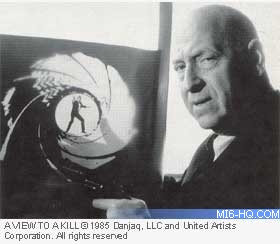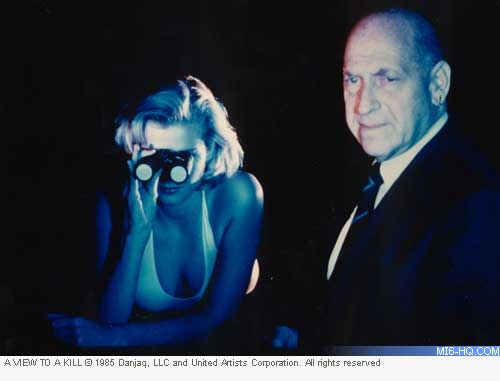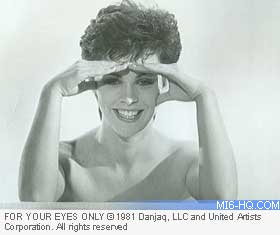 |
| |
MI6 profiles legendary title designer Maurice Binder, examining the iconic nature of the James Bond titles...
|
|
A World Of Icons - The Art Of Maurice Binder
15th April 2008
The James Bond films have set movie-making standards for action, adventure and have often been the first pioneer new and fantastic film techniques. From the pre-title sequence, to the gun barrel icon and lavish main title sequence, every Bond film to date opens with the signature film goers have come to associate with James Bond. Over 40 years since the first Bond picture, it is clear some things never change. MI6 delves into the life and works of main-title artist, Maurice binder as well as analysing all 21 of the title designs to date.
Right: Legendary title designer, Maurice Binder poses with his iconic gunbarrel concept...
The man behind 15 of the title sequences is Maurice Binder. Born on the 25th of August 1925, Binder grew up New York, where he formally studied to become an artist. After his spell in the world of higher education - deciding formal artistry was not for him - Binder worked his way through the ranks of design and marketing companies to take up the prestigious position of Macy's advertising director.
|
|

Datastream
Name: Maurice Binder
Date of Birth: 25th August 1925
Date of Death: 9th April 1991
Bond Titles:
14
Active Career: 1958-1993
|
|
With a flare for the outlandish and a passion for entertainment, Binder quickly grew tired of the PR and marketing world and tried his hand at movies. Working first at Universal Studios and then for Columbia Pictures Binder's talent was quickly recognised and put to brilliant use.
He was first offered the job of designing a feature film title sequence in 1958 by director Stanley Donen for his production of "Indiscreet". Binder became a regular face on many of Donen's productions before being picked up by the Bond family. It was his work on "The Grass Is Greener" (1960) that caught Bond producer, Cubby Broccoli's eye, and thus won him the job on "Dr. No", just a year later.
Of all his collogues interviewed, every one of them remarked on the charming nature of Maurice Binder, but also how private he kept his life. Over 72 years, Binder never married - although many would not hesitate to describe him as a womaniser.
Pop-Bond
Binder immersed himself in the pop-art movement of the '60s and the effect on many of his Bond titles is astounding. Bright colour and icon after memorable icon don his spectacularly sensual title sequences. The world of graphic design and even comic-strip art is in full swing in 1962 and from here Binder takes inspiration for his Bond titles.

Above: Maurice Binder directs a model as he shoots the title sequence for "A View To A Kill"... |
The first Bond title, "Dr. No" while simple in itself and expresses this pop-art movement perfectly. The coloured spheres that flash brightly, blended with the movement of silhouetted dancing girls - who become a regular fixture in Binder titles and indeed icons of the James Bond cinema experience.
It is unusual to think that while the pop-art movement rages on within 007's title sequence the rest of the Bond image snubs '60s culture, gauging a valley between the pot-smokers and the martini-drinkers - undoubtedly two prominent icons of the time.
James Bond began giving cinemagoers an icon
to idolise and a fantasy world to engulf them in for just two
hours of their life. The fantasy and the allure of Binder's
iconic titles, with their dancing girls, scantly clad in underwear
(or nothing at all), gives these Bond films a feel of the times.
Binder's friends and collogues would remark in years to come
how easily he managed to get his models' clothes off! Binder
had the gift of the gab, artistic vision and often only 3 days
to create a Bond credit sequence.
Bending the rules
For 45 years the Bond title sequences have enchanted their audiences - often after an enthralling piece of stunt work that constitutes the pre-title sequence - lulling them into a steamy sense of lust or love and perfectly accompanied by Shirley Bassey, Tom Jones, Nancy Sinatra or Sheena Easton.
Not many of the Binder titles broke this formula of success, but with every icon, there are subtle developments. The 10th Bond picture, "The Spy Who Loved Me", sees a new silhouette join the regular round up of ladies. James Bond himself makes a debut in Spy's title sequence! In the form of Roger Moore, James Bond slips his way into the Binder titles.
Suddenly it's the 1980s, and the Bond family have produced 11 successful pictures, each time delighting the audience and provoking the sex and sadism of James Bond. Times are changing, regular composer John Barry comes and goes in this period, the beautiful orchestration of the Bond era makes a twist and then a turn and composers such as Marvin Hamlisch and Bill Conti put their own spin on the sound of Bond… cue Sheena Easton.
|
|

Above: Sheena Easton,
the only title artist to appear on-screen in the credits,
performs "For Your Eyes Only" for the cameras...
|
Binder's fascination with this title artist leads her to become the one and only musician to perform her title song on-screen. Not before or since has a title artist appeared in the credit sequence. Easton's "70-millimeter lips" are today famous unto Bond fans and filmgoers alike - many thanks to Maurice Binder.
Time plods on and the late '80s see Timothy Dalton, a more reserved, one-woman 007. The AIDS-scare puts a temporary hiatus to the openness of Bond's sexual exploits, and in some ways the titles begin to reflect this. Never the less, all the while Binder worked on Bond he never rested - always aiming to top previous attempts. His final Bond title, and indeed is final ever title design job, "Licence To Kill" sees lavish women brandying cameras in classic Binder style. The lull in Bond productions sees Binder work on token productions during the early '90s - including Mel Gibson's "Hamlet" and soon-to-be-Bond, Pierce Brosnan's "Mr. Johnson".
On the 9th of April, 1991, Maurice Binder passed away after suffering lung cancer, in London, England. Binder's triumphs still wow and stir cinema audiences and his traditions are echoed in modern Bond productions thanks to the digital art of Daniel Kleinman.
Related Articles
 Biographies
Biographies
 Movie Index
Movie Index
 Music Index
Music Index